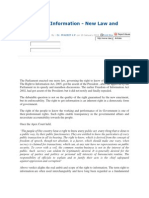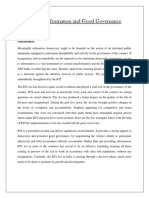RTI Notes
RTI Notes
Uploaded by
Kaushik JainCopyright:
Available Formats
RTI Notes
RTI Notes
Uploaded by
Kaushik JainOriginal Title
Copyright
Available Formats
Share this document
Did you find this document useful?
Is this content inappropriate?
Copyright:
Available Formats
RTI Notes
RTI Notes
Uploaded by
Kaushik JainCopyright:
Available Formats
THE RIGHT TO INFORMATION
HISTORICAL BACKGROUND
The right to information is a fundamental right under Article 19 (1) of the Indian
Constitution. In 1976, in the Raj Narain vs the State of Uttar Pradesh case, the Supreme Court
ruled that Right to information will be treated as a fundamental right under article 19. The
Supreme Court held that in Indian democracy, people are the masters and they have the right
to know about the working of the government.
Thus the government enacted the Right to Information act in 2005 which provides machinery
for exercising this fundamental right.
INTRODUCTION-
The act is one of the most important acts which empowers ordinary citizens to question the
government and its working. This has been widely used by citizens and media to uncover
corruption, progress in government work, expenses-related information, etc.
The primary goal of the Right to Information Act is to empower citizens, promote openness
and accountability in government operations, combat corruption, and make our democracy
truly function for the people. It goes without saying that an informed citizen is better
equipped to keep a required track on governance instruments and hold the government
responsible to the governed. The Act is a significant step in informing citizens about the
activities of the government.
All constitutional authorities, agencies, owned and controlled, also those organisations which
are substantially financed by the government comes under the purview of the act. The act also
mandates public authorities of union government or state government, to provide timely
response to the citizens’ request for information.
The act also imposes penalties if the authorities delay in responding to the citizen in the
stipulated time.
Objectives of the RTI Act
1. Empower citizens to question the government.
2. The act promotes transparency and accountability in the working of the government.
3. The act also helps in containing corruption in the government and work for the people
in a better way.
4. The act envisages building better-informed citizens who would keep necessary vigil
about the functioning of the government machinery.
Important provisions under the Right to Information Act, 2005
Section 2(h): Public authorities mean all authorities and bodies under the union
government, state government or local bodies. The civil societies that are substantially
funded, directly or indirectly, by the public funds also fall within the ambit of RTI.
Section 4 1(b): Government has to maintain and proactively disclose information.
Section 6: Prescribes a simple procedure for securing information.
Section 7: Prescribes a time frame for providing information(s) by PIOs.
Section 8: Only minimum information exempted from disclosure.
Section 8 (1) mentions exemptions against furnishing information under the RTI Act.
Section 8 (2) provides for disclosure of information exempted under the Official
Secrets Act, 1923 if the larger public interest is served.
Section 19: Two-tier mechanism for appeal.
Section 20: Provides penalties in case of failure to provide information on time,
incorrect, incomplete or misleading or distorted information.
Section 23: Lower courts are barred from entertaining suits or applications. However,
the writ jurisdiction of the supreme court and high courts under Articles 32 and 226 of
the Constitution remains unaffected.
Significance of the RTI Act
The RTI Act, 2005 empowers the citizen to question the secrecy and abuse of power
practised in governance.
It is through the information commissions at the central and state levels that access to
such information is provided.
RTI information can be regarded as a public good, for it is relevant to the interests of
citizens and is a crucial pillar for the functioning of a transparent and vibrant
democracy.
The information obtained not only helps in making government accountable but also
useful for other purposes which would serve the overall interests of the society.
Every year, around six million applications are filed under the RTI Act, making it the
most extensively used sunshine legislation globally.
These applications seek information on a range of issues, from holding the
government accountable for the delivery of basic rights and entitlements to
questioning the highest offices of the country.
Using the RTI Act, people have sought information that governments would not like
to reveal as it may expose corruption, human rights violations, and wrongdoings by
the state.
The access to information about policies, decisions and actions of the government that
affect the lives of citizens is an instrument to ensure accountability.
Recent Amendments
The RTI amendment Bill 2013 removes political parties from the ambit of the
definition of public authorities and hence from the purview of the RTI Act.
The draft provision 2017 which provides for closure of case in case of death of
applicant can lead to more attacks on the lives of whistleblowers.
The proposed RTI Amendment Act 2018 is aimed at giving the Centre the power to
fix the tenures and salaries of state and central information commissioners, which are
statutorily protected under the RTI Act. The move will dilute the autonomy and
independence of CIC.
The Act proposes to replace the fixed 5-year tenure with as much prescribed by the
government.
You might also like
- T1 - Invitation To TenderDocument11 pagesT1 - Invitation To TenderArga ShaktiNo ratings yet
- The Theory of Karma (English) Hirabhai ThakkarDocument53 pagesThe Theory of Karma (English) Hirabhai ThakkarAKASH100% (3)
- The Right To Information AssignmentDocument6 pagesThe Right To Information AssignmentAbhishek Pratap ChauhanNo ratings yet
- The Right To InformationDocument6 pagesThe Right To InformationShilpa RawatNo ratings yet
- Rti ByjuDocument5 pagesRti ByjuTulasee ReddiNo ratings yet
- Right To InformationDocument8 pagesRight To InformationAnjali PathakNo ratings yet
- Freedom of InfornationDocument5 pagesFreedom of InfornationRitika SinghNo ratings yet
- Research Paper On Right To Information Act 2005Document8 pagesResearch Paper On Right To Information Act 2005Shivansh ChauhanNo ratings yet
- Rti NoteDocument7 pagesRti NoteHimanshu VermaNo ratings yet
- Research Paper On Right To Information Act, 2005Document8 pagesResearch Paper On Right To Information Act, 2005a_adhau100% (6)
- Right To Information Academike 20210223120533Document17 pagesRight To Information Academike 20210223120533SamirNo ratings yet
- 1597628133-Right-To-Information AmendmentDocument6 pages1597628133-Right-To-Information AmendmentAshkar ChandraNo ratings yet
- Right To InformationDocument5 pagesRight To InformationHello HiiNo ratings yet
- The Right To Information - FinalDocument10 pagesThe Right To Information - FinalSaima KhanNo ratings yet
- Right To Information: Why in News?Document5 pagesRight To Information: Why in News?Deepeksh GaurNo ratings yet
- Right To Information - Notes For UPSC Indian PolityDocument11 pagesRight To Information - Notes For UPSC Indian PolityRAJARAJESHWARI M GNo ratings yet
- RTI EssayDocument7 pagesRTI EssayRohit GunasekaranNo ratings yet
- Known Unknowns of RTIDocument7 pagesKnown Unknowns of RTIRajatBhatiaNo ratings yet
- RTI ActDocument9 pagesRTI Actpunkysharma66No ratings yet
- Study of Role of RTI ACT To Prevent Corruption and Capacity Building For Delivery of Government Services: Socio-Economic ImpactDocument4 pagesStudy of Role of RTI ACT To Prevent Corruption and Capacity Building For Delivery of Government Services: Socio-Economic ImpactEditor IJTSRDNo ratings yet
- Civil Society ProjectDocument14 pagesCivil Society Projectayush singhNo ratings yet
- The Right To InformationDocument7 pagesThe Right To InformationMd. Akmal HossainNo ratings yet
- Aditoriyama RtiDocument12 pagesAditoriyama RtiAditya Pratap SinghNo ratings yet
- Session 3 - RTIDocument9 pagesSession 3 - RTI589 TYBMS Shivam JoshiNo ratings yet
- RTIDocument8 pagesRTIDeepanshu ChawlaNo ratings yet
- Ch.1 Introduction: Rti & Good GovernanceDocument16 pagesCh.1 Introduction: Rti & Good Governancenirshan rajNo ratings yet
- Right To Information and Good Governance: AbstractDocument20 pagesRight To Information and Good Governance: Abstractmayank shekharNo ratings yet
- 10 - Chapter-6 PDFDocument39 pages10 - Chapter-6 PDFMoajjem HossainNo ratings yet
- AL Module 8. RTI Act 2005Document13 pagesAL Module 8. RTI Act 2005Aaditya KesariNo ratings yet
- A Study On Right To Information ActDocument42 pagesA Study On Right To Information Actbanaman100% (1)
- Human Rights Unit IIIDocument12 pagesHuman Rights Unit IIIPRAVEENKUMAR MNo ratings yet
- Free Flow of InformationDocument6 pagesFree Flow of InformationSatyendra SinghNo ratings yet
- Supreme Court Judgements On Right To Information - IpleadersDocument11 pagesSupreme Court Judgements On Right To Information - IpleadersDebapom PurkayasthaNo ratings yet
- History of The Right To Information ActDocument9 pagesHistory of The Right To Information ActWaqarKhanPathanNo ratings yet
- Dr. Ram Manohar Lohiya National Law University Lucknow: Civil Society and Public GrievancesDocument8 pagesDr. Ram Manohar Lohiya National Law University Lucknow: Civil Society and Public GrievancesJitesh SharmaNo ratings yet
- Dr. Ram Manohar Lohiya National Law University Lucknow: Civil Society and Public GrievancesDocument8 pagesDr. Ram Manohar Lohiya National Law University Lucknow: Civil Society and Public GrievancesJitesh SharmaNo ratings yet
- An Analysis of The Section - 8 (1) (D), (G), (I) of The RTI ActDocument19 pagesAn Analysis of The Section - 8 (1) (D), (G), (I) of The RTI Actbackupsanthosh21 dataNo ratings yet
- RIGHT TO INFORMATIONDocument9 pagesRIGHT TO INFORMATIOND.S. AbarnaNo ratings yet
- Unit 5 - 5.1 RTIDocument6 pagesUnit 5 - 5.1 RTI21ubaa140 21ubaa140No ratings yet
- Right To Information ActDocument5 pagesRight To Information ActJustin BennyNo ratings yet
- Killing The Spirit of RtiDocument17 pagesKilling The Spirit of RtiAshutoshNo ratings yet
- Right To InformationDocument9 pagesRight To Informationsaikrishnacr2021No ratings yet
- Right To Information Act, 2005: B.1 Objectives of The ActDocument9 pagesRight To Information Act, 2005: B.1 Objectives of The ActHarshada SinghNo ratings yet
- Internship Research Paper - Vratika PhogatDocument19 pagesInternship Research Paper - Vratika Phogatinderpreet sumanNo ratings yet
- Cyber Monday: View Deals NowDocument11 pagesCyber Monday: View Deals NowvenugopalNo ratings yet
- Importance of Right To InformationDocument5 pagesImportance of Right To InformationvikaskmbNo ratings yet
- Good GovernanceDocument13 pagesGood GovernanceNEEL RAINo ratings yet
- Rti File DocumentDocument41 pagesRti File DocumentVanshika GheteNo ratings yet
- The Right of The People To Information On Matters and Documents of Public ConcernDocument3 pagesThe Right of The People To Information On Matters and Documents of Public ConcernAira RamosNo ratings yet
- RTI Assignment 17 HGHJGHJFHJDocument9 pagesRTI Assignment 17 HGHJGHJFHJMd Haider AnsariNo ratings yet
- Transparency - GovernanceDocument9 pagesTransparency - GovernanceSajithasri KNo ratings yet
- Administrative Law ProjectDocument21 pagesAdministrative Law ProjectAnonymous H1TW3YY51KNo ratings yet
- Right To InformationDocument12 pagesRight To InformationDevesh AtriNo ratings yet
- Internship Research Paper - Vratika PhogatDocument19 pagesInternship Research Paper - Vratika PhogatNayan SinghNo ratings yet
- 26 RTIDocument4 pages26 RTIyashumishra325No ratings yet
- 6 Right To Information ActDocument13 pages6 Right To Information Actipmx17069No ratings yet
- Importance of RTIDocument2 pagesImportance of RTItanaya2002nandaNo ratings yet
- FD Polity PDFDocument14 pagesFD Polity PDFVyom TiwariNo ratings yet
- Right To Information Act (In Medical Practice)Document25 pagesRight To Information Act (In Medical Practice)P Vinod Kumar100% (1)
- A Layman’s Guide to The Right to Information Act, 2005From EverandA Layman’s Guide to The Right to Information Act, 2005Rating: 4 out of 5 stars4/5 (1)
- Data Protection vs. Freedom of Information: Access and Personal DataFrom EverandData Protection vs. Freedom of Information: Access and Personal DataRating: 4 out of 5 stars4/5 (1)
- Reaction Paper of SonaDocument6 pagesReaction Paper of SonaOlivia NemirNo ratings yet
- Enigma 2000 Newsletter: Little Sai Wan RAF Wireless Intercept Station Hong KongDocument68 pagesEnigma 2000 Newsletter: Little Sai Wan RAF Wireless Intercept Station Hong KongSAPARI CATNo ratings yet
- Sim CBM 122 Lesson 2Document7 pagesSim CBM 122 Lesson 2Andrew Sy ScottNo ratings yet
- Study Material Criminology II LLM Iv Semester Unit-1Document51 pagesStudy Material Criminology II LLM Iv Semester Unit-1Kathiravan SNo ratings yet
- Tormis Vs ParedesDocument2 pagesTormis Vs ParedesTenet ManzanoNo ratings yet
- The Pearl - John SteinbeckDocument7 pagesThe Pearl - John SteinbeckIrfan RabbaniNo ratings yet
- The Samaritan Essay QnsDocument3 pagesThe Samaritan Essay Qnssiahheartt4No ratings yet
- AAI - Supplier Code of ConductDocument7 pagesAAI - Supplier Code of Conductsales applesteelsNo ratings yet
- Palattao, The Absence of A Public Bidding May Mean That The Government Was Not Able To Secure The LowestDocument2 pagesPalattao, The Absence of A Public Bidding May Mean That The Government Was Not Able To Secure The LowestsophiaNo ratings yet
- Notes For Social ProblemDocument7 pagesNotes For Social ProblemKathlyn BalucanNo ratings yet
- G5 - IKEAs Global RenovationDocument8 pagesG5 - IKEAs Global RenovationAnh Nguyen Tran TuNo ratings yet
- Political Dynasties and The Emergence of Local Oligarchs in Post-Suharto Indonesia and The PhilippinesDocument22 pagesPolitical Dynasties and The Emergence of Local Oligarchs in Post-Suharto Indonesia and The PhilippinesNajmu Laila SopianNo ratings yet
- Press ReleaseDocument1 pagePress ReleaseKMNo ratings yet
- What Is Wirecard?: How Did The Wirecard Scandal Unfold?Document3 pagesWhat Is Wirecard?: How Did The Wirecard Scandal Unfold?Umar AliNo ratings yet
- Ethics (Mains Booster) - 2024Document132 pagesEthics (Mains Booster) - 2024duckconfirmNo ratings yet
- Chapter VDocument69 pagesChapter VMangaldip MukherjeeNo ratings yet
- I. Opening Statement: Iiia. 2 RRLDocument3 pagesI. Opening Statement: Iiia. 2 RRLAdam CuencaNo ratings yet
- The Curse of The Demon Lord - S MarkDocument2 pagesThe Curse of The Demon Lord - S MarkPedro Henrique Nogueira SantosNo ratings yet
- Revision Notes V2Document23 pagesRevision Notes V2Vineela Srinidhi DantuNo ratings yet
- AP Muckrakers WorksheetDocument2 pagesAP Muckrakers WorksheetaadarshNo ratings yet
- Akashganga Infraventures India PVT Ltd-Barmer Rajasthan-247746Document2 pagesAkashganga Infraventures India PVT Ltd-Barmer Rajasthan-247746Jawed Mohd ChouhanNo ratings yet
- Organized Crime Notes-2012-13Document26 pagesOrganized Crime Notes-2012-13ebuan8211No ratings yet
- Problems of Definition: What Is Organized Crime?. Finckenauer James O.Document22 pagesProblems of Definition: What Is Organized Crime?. Finckenauer James O.Gaston AvilaNo ratings yet
- Defamation I: Prepared by Ms. Julia Farhana Binti RosemadiDocument27 pagesDefamation I: Prepared by Ms. Julia Farhana Binti Rosemadiritha57No ratings yet
- Etichs KoDocument136 pagesEtichs KoMike CartajenasNo ratings yet
- CSR Principles: Corporate Social ResponsibilitiesDocument4 pagesCSR Principles: Corporate Social ResponsibilitiesLïkïth RäjNo ratings yet
- Democracyand Dictatorshipin PakistanDocument27 pagesDemocracyand Dictatorshipin PakistanAbdullah ShahidNo ratings yet
- Pagano Vs Nazaro Case DigestDocument3 pagesPagano Vs Nazaro Case DigestStella MarianitoNo ratings yet

























































































